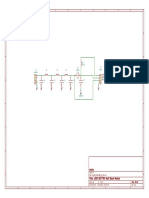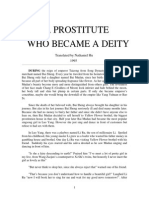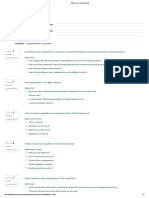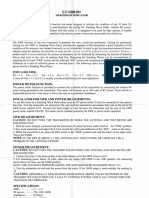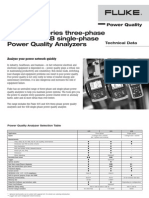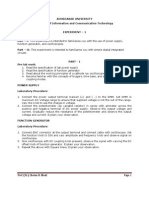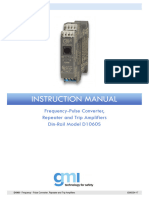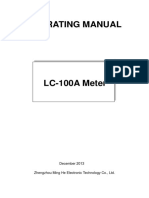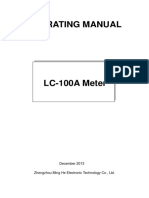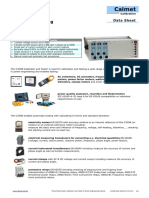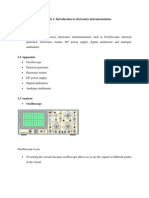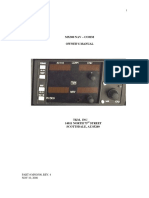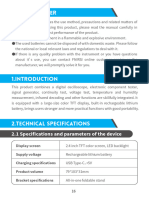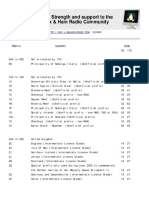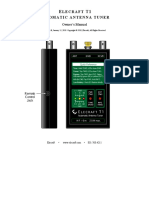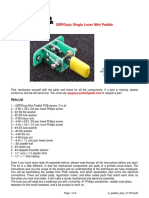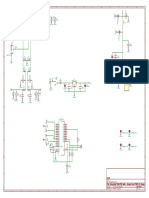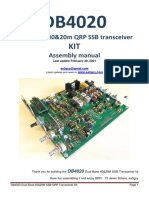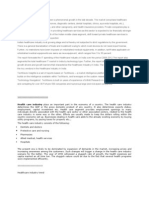MR100 SWR Analyzer: User Manual
MR100 SWR Analyzer: User Manual
Uploaded by
fox7878Copyright:
Available Formats
MR100 SWR Analyzer: User Manual
MR100 SWR Analyzer: User Manual
Uploaded by
fox7878Original Description:
Original Title
Copyright
Available Formats
Share this document
Did you find this document useful?
Is this content inappropriate?
Copyright:
Available Formats
MR100 SWR Analyzer: User Manual
MR100 SWR Analyzer: User Manual
Uploaded by
fox7878Copyright:
Available Formats
WWW.LXQQFY.
COM
MR100 SWR Analyzer
User Manual
Revision 3.0
This product is revised by SARK100, and the technology is from Melchor Varel(EA4FRB)
Rev 3.0 September 12, 2016 - 0- MR100 SWR Analyzer
WWW.LXQQFY.COM
1 Specifications
Frequency Generation & Control:
o 1 - 60 Mhz
o Source impedance: 50 Ohms
o Stability: +/- 100 ppm
o Spectral Purity: Harmonics down >- TBD dB beyond 60 MHz
o Step Size: User configurable increments of 100 Hz, 1 kHz, 10 kHz, and 100 kHz
Usable Measurement Range:
o SWR: 1.0 to 9.99
o Impedance: approx. 5 to 2000 ohms
RF Output:
o Adjustable: 2.0 Volts pp (typ)
Power supply:
o External: 13.8 to 19 Volts DC, 500mA
o Internal: 8xAAA 1000mAh NiMH cells
o Charging time: 12 hours (charge rate 0.1C)
Controls:
o Pushbuttons (5): "Mode", "Band", "Config", "Scan", "Up", "Down"
o Switch: "Power On"
Connectors:
o RF Out: BNC
o USB: Mini-B receptacle
o External power: 2.1mm Power Jack (center pin positive)
Instrument Capabilities:
o Measure antenna electrical parameters: SWR, impedance (resistance +
reactance), capacitance, inductance
o Measure feedpoint impedance
o Measure ground loss
Rev 3.0 September 12, 2016 - 1- MR100 SWR Analyzer
WWW.LXQQFY.COM
o Adjust antenna tuners and determine loss
o Measure inductors and capacitors
o Measure coax transmission line (SWR, length, velocity factor, approximate Q
and loss, resonant frequency, and impedance)
o Measure and determine optimum settings for tuning stubs: SWR, approximate
Q, resonant frequency, bandwidth, impedance
o Determine characteristic impedance of transmission line
o Determine length of ¼ and ½ wave phasing lines
o Coaxial Cable Loss
o Determine antenna tuner loss
o Measure balun loss
o Measure inductor Q
o Estimate quartz crystal parameters
Rev 3.0 September 12, 2016 - 2- MR100 SWR Analyzer
WWW.LXQQFY.COM
2 Connections and Controls
Rev 3.0 September 12, 2016 - 3- MR100 SWR Analyzer
WWW.LXQQFY.COM
3 Connections and Controls
Power-on
Power is turned on to the MR100 by sliding the switch located on the bottom panel. After
power-on the unit will display for half a second the following welcome message:
SARK100 Analyzer
(c) EA4FRB 10 V11
V11 indicates the unit firmware version. This information is important to check on the website of
the project if there is a newer version. Then the instrument automatically switches to impedance
mode that is the default mode and LCD shows frequency, SWR, and the magnitude of the
impedance:
SWR 14,100.000
>10 Z=2000
The analyzer has an automatic power-save function. This function detects that no button was
pressed after a user programmable time and goes into a power saving state and which turns off
the display. In this state the press of any button will start immediately the unit returning to the
same state before the suspension, i.e. the same function and frequency selected. This function
can be disabled by the user.
It is important to note that this is an energy saving feature but not a full power-off, i.e. the
instrument continues to have a significant consumption so it is recommended shutting down
completely in the case it s not going to be used.
User Interface
The user interface consists of six buttons, four aimed at selecting the functions available and two
are used primarily to select the frequency but have the dual function of canceling and validate
respectively. All functions are summarized in the Appendix E:
Adjusting the Frequency
Frequency is changed by adjusting a single digit indicated at the point in the display where the
cursor ‘_’ is by pressing either frequency change button. Upon power-up of the instrument, the
10 kHz digit is the adjustment point, as shown by the digit with the cursor in the display below.
SWR 14,100.000
1.02 Z = 40Ω
To move the cursor to a different digit to be adjusted, press simultaneously the frequency
change buttons. The cursor will move to any of the seven available digits, allowing subsequent
up/down adjustment of that digit after pressing again the frequency change buttons. A blinking
cursor will be display during the digit adjustment mode.
Rev 3.0 September 12, 2016 - 4- MR100 SWR Analyzer
WWW.LXQQFY.COM
SWR 14,1 0.000
1.02 Z = 40Ω
Pressing the left button will increase the digit value and, correspondingly, the signal generated
by the unit. Pressing the right button will decrease the digit and the generated signal.
When the digit is incremented past 9, or when it is decremented past 0, the digits above the
selected adjustment point are rolled up or down, respectively. Using this frequency adjustment
scheme, the user can conveniently pick an “increment” digit and manually scan frequencies with
the desired granularity. Rough scans can manually be done by positioning the cursor under the
100 kHz digit or the 1 MHz digit, giving a wide and course scan of the frequencies with a quick
twist of the dial.
The signal frequency can then be set to the area of interest and the cursor set to a lower
granular digit (e.g., 10 kHz or 1 kHz) in order to manually perform a detailed scan while watching
displayed results for SWR, impedance and reactance.
MODE
Successively pressing the MODE button you can select one of the MR100 operating modes:
impedance (magnitude), complex impedance, capacitance, inductance, and off.
Impedance Mode (magnitude)
This is the main mode of the instrument and measures the SWR and the magnitude of the
impedance. An example screen is the following:
SWR 14,100.000
1.02 Z = 40Ω
• The top line indicates the mode and the frequency
• The first number on the second line is the SWR, in this case 1.02:1
• The second number is the impedance magnitude (modulus), in this case 40 Ω
In this mode the instrument can be used as a VFO as it keeps the signal in the selected
frequency continuously.
Complex Impedance Mode
In this mode it is measured the SWR and the complex impedance. An example screen is the
following:
IMP 14,100.000
1.02 45 + j 50
• The top line indicates the mode and the frequency
• The first number on the second line is the SWR, in this case 1.02:1
Rev 3.0 September 12, 2016 - 5- MR100 SWR Analyzer
WWW.LXQQFY.COM
• The middle value is the resistance, i.e. the real part of the impedance, in this case 45 Ω
• Then it is shown the reactance sign, ‘+’ for inductive reactance and ‘-‘ for capacitive
reactance. If it is not shown, i.e. ‘ ‘ it means that it cannot be determined
• Last term is the reactance, in this case it is 50 Ω inductive reactance
This mode can not be used as a VFO because the frequency is continuously dizzling in order to
determine the reactance sign.
Capacitance Mode
This mode allows the measurement of the capacitance. An example screen is the following:
CAP 14,100.000
C = 112.4 pF
• The top line indicates the mode and the frequency
• The bottom line indicates the capacitance in pF
Capacity values must be within the measurement range of the instrument. Given that the
maximum impedance specification for the analyzer is 2000 Ω, the display will show a numeric
value only when the reactance is less than this value. The formula to calculate the capacity is the
following:
1
XC =
2 × pi × F × C
Inductance Mode
This mode allows the measurement of the inductance. An example screen is the following:
IND 14,100.000
L = 7.8 uH
• The top line indicates the mode and the frequency
• The bottom line indicates the inductance in uH
Inductance values must be within the measurement range of the instrument. Given that the
maximum impedance specification for the analyzer is 2000 Ω, the display will show a numeric
value only when the reactance is less than this value. The formula to calculate the inductance is
the following:
XL = 2 × pi × F × L
Off Mode
In this mode it is disabled the DDS and the impedance measurements.It is provided a RF level
measurement mode where the measured signal level is displayed in the second line of the
Rev 3.0 September 12, 2016 - 6- MR100 SWR Analyzer
WWW.LXQQFY.COM
display as a bar graph. This will be useful to know if the antenna is receiving a near RF field
which can interfere with the measurements.
OFF
BAND
The BAND button allows selecting the working frequency band within the bands available.
Pressing this button sequentially selects the next higher band which value is shown in the LCD,
and it is changed the frequency. If it is the first time accessing the band, the frequency will be set
to the middle value. Otherwise it will be set the previous frequency value, since this is stored
when changing the band.
Band Lower Middle Upper
Frequency Frequency Frequency
160M 1,000.000 1,800.000 2,000.000
80M 2,000.000 3,700.000 5,000.000
40M 5,000.000 7,100.000 8,000.000
30M 8,000.000 10,100.000 11,000.000
25M 11,000.000 12,000.000 13,000.000
20M 13,000.000 14,100.000 17,000.000
17M 17,000.000 18,100.000 19,000.000
15M 19,000.000 21,000.000 23,000.000
12M 23,000.000 24,900.000 26,000.000
11M 26,000.000 27,000.000 28,000.000
10M 28,000.000 29,000.000 31,000.000
8M 31,000.000 40,000.000 49,000.000
6M 49,000.000 51,000.000 53,000.000
SCAN
Pressing the SCAN pushbutton will automatically sweep the antenna analyzer test signal across
the band range previously selected, incrementing from the lower frequency limit to the upper
Rev 3.0 September 12, 2016 - 7- MR100 SWR Analyzer
WWW.LXQQFY.COM
frequency limit, in steps according the programmed step value. During the scan the SWR is
measured and updated on the screen as well as the current frequency value. Each SWR value
is compared to previous value in order to determine if a minima, or a “dip”, has occurred at this
point in the scan. If so, that data point is stored for later display. Besides the 2:1 points are
stored in order to determine the bandwidth. An example screen during the scan is the following
(frequency and SWR are updated continuously):
SCAN 14,100.200
1.30
Notice that when detected the 2:1 SWR points the buzzer is sounded to alert the user of the
event. After the scan process the instrument will show the bandwidth and after pressing any key
the instrument will switch to impedance mode with the frequency set to the frequency value
corresponding to the minimum SWR point.
BW 35.000
Press any key
In the case of not finding a resonance point the unit will display the following error message on
the screen.
Err No Matching
Press any key
CONFIG
Successively pressing the CONFIG button you can select one of the MR100 configuration
modes and extended funtions. To select either option you need to press the button VAL and for
exit you need pressing the button CAN.
PC Link
The PC Link function lets you control the MR100 from your PC using the USB connection.
The PC USB driver provides an emulation of a COM port and the MR100 provides a
command interface so you can be control the instrument from a terminal program such as
HyperTerminal or any other program designed for this purpose, e.g. PCC-SARK100.
To use this feature you must have installed the USB driver, see Appendix A: and connect the
USB cable. The COM port setting is 57600, 8, n, 1, with no hardware flow control. By entering
this function the analyzer will send the following text to the terminal and will display the command
prompt:
SARK SWR Analyzer V05
>>
Rev 3.0 September 12, 2016 - 8- MR100 SWR Analyzer
WWW.LXQQFY.COM
The available commands are described in Appendix C: These can be typed from the
HyperTerminal window and the results will be returned to the terminal. The MR100 will show
the last processed command in the bottom line of the LCD.
Step Size
This function allows you to change the value of the frequency step for the SCAN and for the
increase/decrease frequency buttons for the impedance measurement modes. Successively
pressing the CONFIG button you can select one of the step values. To select either value you
need to press the button VAL and for exit you need pressing the button CAN.
The following values are available: 10Hz, 100Hz, 1kHz, 10kHz, and 100kHz.
Suspend Timeout
This feature allows you to program the user idle time for the automatic power-save feature.
Successively pressing the CONFIG button you can select one of the idle time values. To select
either value you need to press the button VAL and for exit you need pressing the button CAN.
The following values are available: Off (disabled), 30 seconds, 60 seconds, and 90 seconds.
Calibrate
This function allows calibrating the instrument in order to get better accuracy. By entering this
function the user is instructed to follow a series of steps which are described in detail in the
Appendix B:
Software Load
Don’t update software.
Rev 3.0 September 12, 2016 - 9- MR100 SWR Analyzer
WWW.LXQQFY.COM
4 Uses for an Antenna Analyzer
The MR100 antenna analyzer is a useful tool for the amateur radio station or the
homebrewer’s workbench. This section will describe the basic uses, as well some advanced
techniques for which you can use the analyzer to get intermediate measurements in order to
compute the desired result.
4.1 Antenna Measurements
The antenna is simply connected to the analyzer RF output and the analyzer is set to the desired
frequency. The instrument measures the SWR, impedance, resistance, and reactance. The
SCAN function will be helpful to automatically find the resonance frequency and the bandwidth of
the antenna.
4.2 Measure Feed Point Impedance
Connecting the analyzer directly at the antenna terminals or remotely through a halfwavelength
of transmission line allows direct measurement of the antenna terminal impedance. This is often
useful with vertical antennas.
A matching network can be connected to the antenna and then adjusted for best SWR on the
analyzer.
4.3 Measure Ground Losses
With short vertical antennas, measuring the impedance directly at the feedpoint allows
estimation of ground loss or loading coil loss. For example a ¼ wave vertical will have a
resistance of about 36 ohms at resonance. Any higher reading indicates ground loss.
Similarly shorter antennas (when resonated) will have lower resistance values. Reading a good
SWR may mean excess loss and measuring the actual impedance allows gauging just how
much loss.
4.4 Adjust Antenna Tuners
The analyzer can be used to adjust an antenna tuner for a perfect match without the need to
transmit a strong signal from the station rig. The analyzer uses only milliwatts of power lessening
the possibility of causing interference, see Figure 3.
4.5 Capacitor Measurement
There are several ways to measure capacitance with the MR100. The simplest is to connect
the capacitor across the RF output connector and select Capacitance from the Mode pushbutton
menu. You can accurately measure capacitance values as long as the reactance at the
measurement frequency is within the impedance measurement specifications of the analyzer
(about 10 to 2000 Ω).
Rev 3.0 September 12, 2016 - 10- MR100 SWR Analyzer
WWW.LXQQFY.COM
Another way to measure capacitance with the MR100 is to measure it in a series resonant
circuit. (See Figure 1 and Figure 5). You will need an inductor of known value and a 51 Ω
carbon composition or film resistor. It is recommended that a small 5% tolerance choke with an
inductance of between 1 and 10 uH be used. Common RF chokes are fine and can be obtained
from most full-service mail order component suppliers.
Figure 1
To measure capacitance by the second method, connect the components as shown in Figure 1.
Then adjust the operating frequency for lowest SWR and record the frequency. Now you can
calculate the capacitance using the formula:
25530
C = F×F×L
Where C is the capacitance in picofarads, F is the frequency in MHz and L is the inductance in
microhenries.
4.6 Inductor Measurement
There are several ways to measure inductance with the MR100. The simplest way is to
connect the inductor across the RF output connector and select Inductance from the Mode
pushbutton menu. You can accurately measure inductor values as long as the reactance at the
measurement frequency is within the impedance measurement specifications of the analyzer
(about 10 to 2000 Ω).
Another way to measure inductance with the MR100 is to measure it in a series resonant
circuit. (See Figure 1 and Figure 5). You will need an capacitor of known value and a 51 Ω
carbon composition or film resistor. The capacitor should have a tolerance no wider than 10%
and have a low loss dielectric composition such as NP0 ceramic or mica. A capacitance value of
about 100 pf is appropriate for many RF measurements.
You can make your own precision capacitor from a piece of coaxial cable. Common RG-58 type
50 ohm coax has a capacitance of about 29 to 30 pf. For example RG58/U is specified at 28.8 pf
per foot so a length of about 3.5 ft – including a 1” pigtail for attachment will serve as a fairly
accurate 100 pf capacitor.
Rev 3.0 September 12, 2016 - 11- MR100 SWR Analyzer
WWW.LXQQFY.COM
To measure inductance by the second method, connect the components as shown in as Figure
6. Adjust the operating frequency for lowest SWR and record the frequency. Now you can
calculate the capacitance using the formula:
25530
L = F × F ×C
Where L is the inductance in microhenries, F is the frequency in MHz and C is the capacitance
in picofarads.
4.7 Measure Inductor Q
The Q of an RF inductor can be measured with a very simple setup. First measure the inductive
reactance XL of the inductor and record this value. Now connect it to the Analyzer as shown
below in Figure 2.
Figure 2
Capacitor C must be chosen to resonate with L at the frequency where you want to measure the
inductor’s Q. The Inductor and Capacitor Measurement section of this manual shows how this
capacitor value can be determined. Now tune the Analyzer for the lowest R (resistance) value
with a reading of zero X (reactance). If R is above 10 ohms you can now calculate inductor Q
using the formula:
XL
Q= R
If R is less than 10 Ω a slightly different method needs to be used. In this case use the test setup
shown in Figure 1. Adding the noninductive (carbon composition or film) ¼ or ½ watt 51 Ω
resistor allows more accurate measurement of the series resistance of the inductor.
Again tune the analyzer for lowest R (resistance) value with a reading of zero X (reactance).
Record this resistance value. Now connect the 51 Ω resistor directly across the analyzer’s RF
output connector and measure its exact value at the resonance frequency and record it. Next
subtract the exact 51 Ω resistor value from the measured R value and use this new resistance in
the above formula to calculate the Q value.
Rev 3.0 September 12, 2016 - 12- MR100 SWR Analyzer
WWW.LXQQFY.COM
4.8 Transmission line characteristic impedance
The characteristic impedance of coaxial, twisted pair, open wire or ribbon type feedlines can be
estimated using the MR100. Practical measurements are best done in the mid-tuning range of
the instrument where accuracy is optimum and feedline lengths are reasonable; so this
procedure will be performed between 7 and 21 MHz.
The measurements need to be done with a transmission line over frequencies where the
feedline is at about 1/8 wavelength at the low frequency end and something over ¼ wavelength
at the high frequency end, so it is recommended that a length of about 4.9m (16 feet) is used.
Connect the near end of the feedline to the MR100. Connect a 1000 Ω carbon or Cermet
potentiometer to the far end with leads no longer than 2.5 cm (one inch) or so. Initially set the pot
to its highest value, see Figure 6.
Ensure that the transmission line is supported for its entire length in a fairly straight line and kept
several inches from any conductive surface or material. This is important to minimize any
detuning effects. Ideally the line should be dressed along to top of a wooden fence or supported
by fiber rope or string.
Now tune the MR100 over the range of 7-to-21 MHz while noting the resistive (R) and reactive
(X) values. More than likely they will vary widely over the tuning range. Now readjust the
potentiometer to a slightly lower value and do another sweep while observing the variation of R
and X values. At some potentiometer setting the R value will vary very little over the tuning range
while the X value will remain near zero. This is the estimated characteristic resistance.
4.9 Transmission line losses
Transmission line loss for 50-ohm feedlines can be easily measured using the analyzer. The
basic operating principle is that loss in transmission lines attenuates RF sent through them.
When the line is connected to the analyzer and the far end is short or opencircuited there is a
theoretically infinite SWR. If the feedline had zero loss this would be the case. However since
any real line has some loss both the forward and reflected power are attenuated and a finite
SWR is measured.
For most good quality new coaxial feedlines the loss at HF frequencies will not exceed several
dB per 30 meters (hundred feet); however as they age the dielectric becomes lossy to it is a
good idea to periodically check the loss. Measurement is simple. All you have to do it is to
remove the load, short-circuit the far end of the feedline, and then connect the near end to the
analyzer’s RF output connector. Measure the SWR and refer to table below for the approximate
corresponding loss. If the measured SWR is above 9:1 that’s good news since the SWR then is
less than 1 dB. If you vary the analyzer frequency you will see that SWR decreases with
frequency indicating that loss increases at higher frequencies.
Rev 2.0 July 25, 2015 - 13 - MR100 SWR Analyzer
WWW.LXQQFY.COM
Approx Loss Measured SWR
1 dB 9:1
2 dB 4.5:1
3 dB 3:1
4 dB 2.3:1
5 dB 2:1
6 dB 1.7:1
7 dB 1.6:1
8 dB 1.5:1
9 dB 1.4:1
10 dB 1.3:1
4.10 Transmission line stub lengths
Measurement of quarter and half wave transmission line stubs can be performed regardless of
the transmission line characteristic impedance. The method relies on the fact that an open-
circuited quarter wavelength line or a short-circuited line acts like a precise short circuit at the
chosen frequency of operation.
With either type of feedline first cut it about 10% longer than the desired length, taking the
appropriate velocity factor into account. The velocity factor of common feedlines is available
from manufacturer’s literature or references such as the ARRL Antenna Book. If you cannot find
the value or if you are using a custom type of feedline, the “Velocity Factor Measurement”
section in this manual provides a way to determine this value. The following formulas can be
used to estimate the length of transmission line required.
For a half-wavelength stub the length is:
150000 × VF
L= F
Where L is the length in cm, VF is the velocity factor and F is the operating frequency in MHz for
the stub.
Similarly for a quarter-wave stub use the formula:
7500 × VF
L= F
Rev 2.0 July 25, 2015 - 14 - MR100 SWR Analyzer
WWW.LXQQFY.COM
To determine the length of a half wave stub, connect the near end of the transmission line
through a 51 Ω resistor as shown in Figure 4 to the analyzer’s RF output connector. Short circuit
the two leads at the far end of the half wave stub.
Ensure that the transmission line is supported for its entire length in a fairly straight line and kept
several inches from any conductive surface or material. This is important to minimize any
detuning effects. Ideally the line should be dressed along to top of a wooden fence or supported
by fiber rope or string.
Now tune the MR100 for minimum SWR and note the frequency. This is the frequencywhere
the transmission line is exactly a half wavelength long. If the initial length was chosen properly it
should be below the desired frequency. If so, cut off a short length making sure the far end is still
short-circuited, and repeat until resonance is achieved at the desired frequency.
For a quarter wave stub, the above procedure can be used except, of course that the length is
different and that the far end needs to be opencircuited.
4.11 Transmission line velocity factor
Velocity factor of a transmission line can be measured using techniques similar to the ones used
for measuring quarter and half wave stubs. The procedure can be performed at any frequency
that the MR100 tunes but it is most practical in the vicinity of 10 MHz where line lengths are
reasonable and instrument accuracy is optimum.
Either a quarter wave or half wave length can be used; but using the shorter length consumes
less feedline if it will be discarded after the measurement. Begin by cutting a quarter wavelength
of feedline using the formula:
7500 × VF
L= F
For a frequency of 10 MHz and assuming a VF (Velocity Factor) of 1.
Now connect the near end of the feedline to a 51 Ω resistor as shown in Figure 7 then to the
analyzer’s RF output connector. The far end must be open circuited. Ensure that the
transmission line is supported for its entire length in a fairly straight line and kept several inches
from any conductive surface or material. This is important to minimize any detuning effects.
Ideally the line should be dressed along to top of a wooden fence or supported by fiber rope or
string.
Now tune the MR100 for lowest SWR and note the frequency. VF can now be calculated
using the formula:
10
VF =
F
Where F is the measured frequency in MHz.
Rev 2.0 July 25, 2015 - 15 - MR100 SWR Analyzer
WWW.LXQQFY.COM
Figure 3,Adjust antenna tuners
Figure 4, ,Adjust antenna tuners
Figure 5, Capacitor or inductor measurement
Figure 6, Determining feedline characteristic impedance
Figure 7, Determining feedline velocity factor
Rev 2.0 July 25, 2015 - 16 - MR100 SWR Analyzer
WWW.LXQQFY.COM
5 PC Software
The MR100 is controllable from the PC and allows the collection of measurements to be
processed by an analysis program. In the project website you can find a simple command line
program, PCC-SARK100, which performs control and data capture from the MR100 and
generates a data file compatible with Excel macro ZPlots from Dan Maguire AC6LA. This macro
performs the analysis of the measures and displays them in different graphs.
PCC-SARK100.zip
Double click download:
The PCC-SARK100 is a simple command line program which scans in the selected frequency
range and stores the measurement results in a file format supported by ZPlots.
Usage:
PCC-SARK100 -c<com port> -s<start freq> -e<end freq> -t<step value> -o<output file>
Where:
• -c<com port name> COM port name
• -s<start freq> Start frequency in Hertz
• -e<end freq> End frequency in Hertz
• -t<step> Step value in Hertz
• -o<output file> Output file name (without path)
Example:
》 PCC-SARK100 -cCOM5 -s14000000 -e16000000 -t10000 -oDipole20m.csv
ZPlots
ZPlots is an Excel macro developed by Dan Maguire AC6LA, which provides the data analysis
and display graphs of the impedance data captured by the MR100 antenna. Usage is very
simple, you select the file captured by PCC-SARK100 and automatically displays a
representation of the actions of the antenna to the SWR, resistance, reactance, etc.. It also
represents Smith chart format. In the following pages there are examples of ZPlots graphs.
The complete manual of the original program is available on the project website.
Rev 2.0 July 25, 2015 - 17 - MR100 SWR Analyzer
WWW.LXQQFY.COM
Appendix A: USB Driver Installation
The MR100 incorporates a USB interface for PC connection. This interface is implemented by
the FTDI Chip FT232R chip which requires prior installation of a driver "Virtual COM Port (VCP)
available at the following link:
http://www.ftdichip.com/Drivers/VCP.htm
This driver is available for multiple operating systems on which you access the manufacturer's
website and select the appropriate driver, always bearing in mind that the chip is the FT232R.
Preferably you install by using the "setup executable" and following the manufacturer's
instructions.
Once installed and connected the MR100 you can verify proper installation by entering in the
Device Manager of the Windows Control Panel. By connecting the MR100 you should see a
new COM port with the FTDI driver reference. Please note the COM port name as it will be
necessary to know to use the MR100 from your PC, eg for software updates or to control the
instrument from HyperTerminal.
Rev 2.0 July 25, 2015 - 18 - MR100 SWR Analyzer
WWW.LXQQFY.COM
Appendix B: Calibrating the Analyzer
To improve the accuracy of the analyzer this should be calibrated. This is a simple procedure
that just requires loads of known value and follows the outlined procedures. The calibration data
is stored in nonvolatile memory and will remain stored during the life of the instrument.
Recalibration will be necessary in the case of a software update because the stored calibration
data are lost during the loading process.
It is essential to properly implementing the loads by integrating in BNC connectors and
minimizing the length of the connections. Another method is to use a BNC to RCA adapter and
mount the resistors in RCA connectors, as they are cheap and easy mounting of resistors, as
shown in the following illustration:
The instrument normalizes the gains of the four legs of the bridge for the different bands of
operation, creating the correction values to be stored in nonvolatile memory. These correction
values are calculated for different load conditions during the calibration process and are
subsequently used for measures to compensate for gain differences of the legs of the bridge.
Calibration Procedure
1. Select the "Calibrate" on the setup menu
2. The instrument will prompt the user with the LCD text “Disconnect Load”, indicating to
remove any load from the RF connector. Press the button VAL after disconnecting the
load and then the display will show “In Progress…” indication that calibration is in
progress
3. Then it will prompt to connect a 50 Ω load “Conn 50 Ω Load”. Plug the 50 Ω load and
then press VAL. The display will show “In Progress…” indication that calibration is in
progress
4. After that it will prompt to connect a 150 Ω load “Conn 150 Ω Load”. Plug the 150 Ω load
and then press VAL. The display will show “In Progress…” indication that calibration is in
progress
Rev 2.0 July 25, 2015 - 19 - MR100 SWR Analyzer
WWW.LXQQFY.COM
5. Subsequently it will prompt to connect a 274 Ω load “Conn 274 Ω Load”. Plug the 274 Ω
load and then press VAL. The display will show “In Progress…” indication that
calibration is in progress
6. Once the calibration is finished it will show the text “Done”. This means that the
calibration process has been completed and stored in the EEPROM. Just press VAL to
continue
Rev 2.0 July 25, 2015 - 20 - MR100 SWR Analyzer
WWW.LXQQFY.COM
Appendix C: Making a Dummy Antenna for Testing
It may be desirable to have a dummy antenna for testing the MR100. A dummy antenna is
simply a three-component circuit that is resonant at a specific frequency and has a purely
resistive characteristic at the resonance frequency. The dummy antenna can be used in place of
a real antenna during initial testing of the instrument.
The dummy antenna consists of one resistor, one inductor and a capacitor in a series circuit,
built at the end of a BNC connector that can be connected to the MR100 antenna. The table
below shows the component values for dummy antennas to any of the specified frequencies:
Freq (Mhz) C (pF) L (uH) Core #Turns
7.1 82 6.8 T50‐2 37
10.1 47 5.28 T50‐2 33
14.1 27 4.7 T50‐2 31
18.1 22 3.51 T37‐2 30
21.2 27 2.08 T37‐2 23
28.5 15 2.08 T37‐2 23
47Ω
C L
Single Resonance
Rev 2.0 July 25, 2015 - 21 - MR100 SWR Analyzer
WWW.LXQQFY.COM
Appendix D: PC Command Interface
Command On
Description Enables DDS signal generation. Requires setting correct DDS
frequency
Arguments ‐‐
Response OK
Error response Error: freq not set
Example >>on
OK
Command off
Description Disables DDS signal generation
Arguments ‐‐
Response OK
Error response ‐‐
Example >>off
OK
Command freq
Description Sets DDS frequency
Arguments {frequency} Frequency in Hertz
Response OK
Error response Error: invalid freq
Example >>freq 14070000
OK
Rev 2.0 July 25, 2015 - 22 - MR100 SWR Analyzer
WWW.LXQQFY.COM
Command imp
Description Get impedance values
Arguments ‐‐
Response {SWR},{R},{X},{Z}
Error response ‐‐
Example >>imp
1.05,52,10,51
Command raw
Description Get raw bridge voltages
Arguments ‐‐
Response {Vf},{Vr},{Vz},{Va}
Error response ‐‐
Example >>raw
257300,165500,31800,214500
Rev 2.0 July 25, 2015 - 23 - MR100 SWR Analyzer
WWW.LXQQFY.COM
Command scan
Description Scans from specified start to end frequency and get impedance
values
Arguments {freq_start} Start freq. in Hz
{freq_end} End freq. in Hz
{step} Step in Hz
Response Start
{SWR},{R},{X},{Z}
{SWR},{R},{X},{Z}
…
End
Error response Error: expected freq val
Error: expected step val
Example >>scan
Start
1.05,52,10,51
1.05,52,10,51
..
End
Rev 2.0 July 25, 2015 - 24 - MR100 SWR Analyzer
WWW.LXQQFY.COM
Command Scanr
Description Scans from specified start to end frequency and get raw bridge
voltages
Arguments {freq_start} Start freq. in Hz
{freq_end} End freq. in Hz
{step} Step in Hz
Response Start
{Vf},{Vr},{Vz},{Va}
{Vf},{Vr},{Vz},{Va}
…
End
Error response Error: expected freq val
Error: expected step val
Example >>scan
Start
257300,165500,31800,214500
257300,165500,31800,214500
…
End
Rev 2.0 July 25, 2015 - 25 - MR100 SWR Analyzer
WWW.LXQQFY.COM
Appendix E: Quick Reference Sheet
Rev 2.0 July 25, 2015 - 26 - MR100 SWR Analyzer
You might also like
- GLPH 385 Final Exam NotesDocument118 pagesGLPH 385 Final Exam Notescameronwallace.10No ratings yet
- Absolute Beginner Guide NanoVNA v1 6Document75 pagesAbsolute Beginner Guide NanoVNA v1 6fox7878100% (3)
- uSDX, All Mode SDR Transceiver, Ver: 1.02Document1 pageuSDX, All Mode SDR Transceiver, Ver: 1.02fox787867% (3)
- Barb - A - Watt QRP Power - SWR MeterDocument18 pagesBarb - A - Watt QRP Power - SWR Meterfox7878100% (1)
- Emtech ZM-2 ATUDocument6 pagesEmtech ZM-2 ATUfox7878No ratings yet
- Advanced Periodic TrendsDocument4 pagesAdvanced Periodic TrendsBianca RolstonNo ratings yet
- Moral Theology and Virtue EthicsDocument36 pagesMoral Theology and Virtue EthicsyzayNo ratings yet
- A Prostitute Who Became A DeityDocument6 pagesA Prostitute Who Became A DeityJames SmithNo ratings yet
- SASE - Quiz - Attempt Review3Document2 pagesSASE - Quiz - Attempt Review3ZORO GAMING PIRATESNo ratings yet
- MR300 SWR Analyzer User ManualDocument31 pagesMR300 SWR Analyzer User ManualMircea Carnicianu100% (1)
- Aw07a User Manual v.16Document7 pagesAw07a User Manual v.16Mark van DommelenNo ratings yet
- VSWR Meter Operation: A-VSWR Measuring Equipment and TechniquesDocument7 pagesVSWR Meter Operation: A-VSWR Measuring Equipment and Techniquesmadhus.054212692No ratings yet
- A Project Report OnDocument20 pagesA Project Report OnSanjeev ManralNo ratings yet
- Cathode Ray OscilloscopeDocument4 pagesCathode Ray Oscilloscoperishitabansal0318No ratings yet
- Aa 600 1000 1400 ManualDocument40 pagesAa 600 1000 1400 ManualJorge A. MoreNo ratings yet
- Depl InductivDocument13 pagesDepl InductivaLeXaNdRu BiscuitNo ratings yet
- Medidor ROEDocument2 pagesMedidor ROEmazatlNo ratings yet
- Lab 2 Slotted Line and SWR MeterDocument6 pagesLab 2 Slotted Line and SWR MeterFrew FrewNo ratings yet
- CPI WM-1000 - WM-7000 Service ManualDocument8 pagesCPI WM-1000 - WM-7000 Service Manualkylecom3No ratings yet
- Mfm374 User ManualDocument45 pagesMfm374 User ManualViệt Cường Phan NguyễnNo ratings yet
- Power Quality Analyzer: Class SDocument4 pagesPower Quality Analyzer: Class Smuhdshafiq12No ratings yet
- HArware For Ultrasonic Range MeterDocument16 pagesHArware For Ultrasonic Range MeterMurtaza HasanNo ratings yet
- 4system OverviewDocument7 pages4system OverviewWajaht AliNo ratings yet
- DC Voltage/Current Generators/Calibrators: For Evaluating and Calibrating Precision Instruments and CircuitsDocument2 pagesDC Voltage/Current Generators/Calibrators: For Evaluating and Calibrating Precision Instruments and CircuitsnameNo ratings yet
- MFJ - Mfj-989c ManualDocument10 pagesMFJ - Mfj-989c ManualSAJEEV SUKUMARNo ratings yet
- Experiment No 1 AM TransmitterDocument6 pagesExperiment No 1 AM TransmitterashfaqiNo ratings yet
- Fluke 430 SeriesDocument8 pagesFluke 430 SeriesEndar YaniNo ratings yet
- CRO 30 MHZDocument31 pagesCRO 30 MHZilesh22No ratings yet
- Experiment 1Document3 pagesExperiment 1chetan_bhattNo ratings yet
- EncodersfaqDocument2 pagesEncodersfaqLuis Antonio Hernandez JimenezNo ratings yet
- Ac Lab ManualDocument16 pagesAc Lab ManualFatima SaeedNo ratings yet
- VSWR Meter Operation: A-VSWR Measuring Equipment and TechniquesDocument7 pagesVSWR Meter Operation: A-VSWR Measuring Equipment and TechniquesPrasad AhireNo ratings yet
- Exp 02 IOBoard RED2Document19 pagesExp 02 IOBoard RED2Daniel AdebayoNo ratings yet
- ML 4803A POWER METER ANRITSU PDFDocument4 pagesML 4803A POWER METER ANRITSU PDFRené CascoNo ratings yet
- Electronic Measurement & Instrumentation Lab Lab Manual: Vi SemesterDocument41 pagesElectronic Measurement & Instrumentation Lab Lab Manual: Vi SemesterMy JaanNo ratings yet
- Micrometer: ProbeDocument27 pagesMicrometer: ProbeJêmš NavikNo ratings yet
- D1060 Ism0054 enDocument11 pagesD1060 Ism0054 enkhaled.essahliNo ratings yet
- Lc100a 2.5 LCD Digital High Precision Inductance Capacitance LC MeterDocument9 pagesLc100a 2.5 LCD Digital High Precision Inductance Capacitance LC MeterMourad hosniNo ratings yet
- Lc100a 2.5 LCD Digital High Precision Inductance Capacitance LC MeterDocument9 pagesLc100a 2.5 LCD Digital High Precision Inductance Capacitance LC MeterChandrashekhar KulkarniNo ratings yet
- Experiment 1 Introduction To The SpectruDocument4 pagesExperiment 1 Introduction To The Spectrusabitha sNo ratings yet
- AC Lab Manual For EceDocument56 pagesAC Lab Manual For EceV SATYA KISHORE100% (5)
- Service Manual: MODEL FG-8110 Sweep/Function GeneratorDocument31 pagesService Manual: MODEL FG-8110 Sweep/Function GeneratorxxNo ratings yet
- Using The Lab InstrumentsDocument78 pagesUsing The Lab InstrumentsTruong Phong TuyenNo ratings yet
- WAMI Lab #0 U48789456Document2 pagesWAMI Lab #0 U48789456Muneebur RehmanNo ratings yet
- 3 Microwave MeasurementsDocument70 pages3 Microwave MeasurementsRavi Shankar100% (1)
- Activity-No.-1 - ELECTRONICS COMMUNICATIONDocument8 pagesActivity-No.-1 - ELECTRONICS COMMUNICATIONHoney PunoNo ratings yet
- C300B Three Phase Power Calibrator Data Sheet enDocument6 pagesC300B Three Phase Power Calibrator Data Sheet enRangga K NegaraNo ratings yet
- SWR 3 Binder12Document2 pagesSWR 3 Binder12javier258No ratings yet
- Vc97 User ManualDocument8 pagesVc97 User ManualWilliam ConejoNo ratings yet
- Experiment 1: Introduction To Electronics InstrumentationsDocument17 pagesExperiment 1: Introduction To Electronics InstrumentationsSharifah Syed HamzahNo ratings yet
- Accu VarDocument4 pagesAccu Varvjvijay88No ratings yet
- Lab InformationDocument13 pagesLab InformationHossain Mohammad MahbubNo ratings yet
- Analog Communications Lab ManualDocument88 pagesAnalog Communications Lab Manualvasantha_btech83% (6)
- Sincronoscopio ISKRADocument7 pagesSincronoscopio ISKRAJose Gutierrez100% (1)
- GF438II Power Qualtiy Analyzer GFUVEDocument9 pagesGF438II Power Qualtiy Analyzer GFUVEjuan jose palma rodriguezNo ratings yet
- Mx300 Nav - Comm Owner'S Manual: PART # MNO300, REV. 4 NOV 10, 2008Document12 pagesMx300 Nav - Comm Owner'S Manual: PART # MNO300, REV. 4 NOV 10, 2008leitopiloto50% (2)
- Displacement Sensors: 1. Resistance Based and Optical Incremental Sensors of Position TaskDocument7 pagesDisplacement Sensors: 1. Resistance Based and Optical Incremental Sensors of Position TaskBoobalan ThirugnanasambandamNo ratings yet
- Huntron Htr-1005b Maintenance SCHDocument38 pagesHuntron Htr-1005b Maintenance SCHRodolfoBucaloNo ratings yet
- Huntron HTR 1005B1S MaintenanceDocument38 pagesHuntron HTR 1005B1S MaintenanceJohn Smith100% (1)
- 02 Study of Functions GeneratorDocument11 pages02 Study of Functions GeneratorGarima SarafNo ratings yet
- Ir Emitter Detector WriteupDocument9 pagesIr Emitter Detector WriteupD Narciso SánchezNo ratings yet
- Use of OscilloscopeDocument13 pagesUse of Oscilloscopesonja_ŽarićNo ratings yet
- LCR 9073aDocument2 pagesLCR 9073aAnonymous sGHvSUoNo ratings yet
- Manual Del Fnirsi Dso-Tc3 InglesDocument20 pagesManual Del Fnirsi Dso-Tc3 InglesabellrNo ratings yet
- Measuring The Impedance of Ultrasonic Transducers: Waldemar Lis, Jan SchmidtDocument6 pagesMeasuring The Impedance of Ultrasonic Transducers: Waldemar Lis, Jan SchmidtHarwi HarwiNo ratings yet
- Reference Guide To Useful Electronic Circuits And Circuit Design Techniques - Part 2From EverandReference Guide To Useful Electronic Circuits And Circuit Design Techniques - Part 2No ratings yet
- Analog Dialogue, Volume 48, Number 1: Analog Dialogue, #13From EverandAnalog Dialogue, Volume 48, Number 1: Analog Dialogue, #13Rating: 4 out of 5 stars4/5 (1)
- M2 Antenna Systems, Inc. Model No: 7&10-30LP8-125: SpecificationsDocument20 pagesM2 Antenna Systems, Inc. Model No: 7&10-30LP8-125: Specificationsfox7878No ratings yet
- Atenuator de 50dBDocument3 pagesAtenuator de 50dBfox7878No ratings yet
- Hustler 4-BTV, 5-BTV, 6-BTV Multiband HF Vertical AntennasDocument64 pagesHustler 4-BTV, 5-BTV, 6-BTV Multiband HF Vertical Antennasfox7878No ratings yet
- A Low-Cost, High-Performance HF Linear Pa Covering 1.8-30MhzDocument35 pagesA Low-Cost, High-Performance HF Linear Pa Covering 1.8-30Mhzfox7878100% (1)
- Class E AmplifiersDocument28 pagesClass E AmplifiersBharath Reddy100% (1)
- ANCOM - Alocare Banda 2mDocument1 pageANCOM - Alocare Banda 2mfox7878No ratings yet
- Prefix, CQ & ITUDocument78 pagesPrefix, CQ & ITUfox7878No ratings yet
- Lecraft Automatic Antenna Tuner: Owner's ManualDocument12 pagesLecraft Automatic Antenna Tuner: Owner's Manualfox7878No ratings yet
- Yaesu Ft8x7 Cat Interface v1.0 de Sv3jyyDocument9 pagesYaesu Ft8x7 Cat Interface v1.0 de Sv3jyyfox7878No ratings yet
- Txtopper List of MaterialsDocument1 pageTxtopper List of Materialsfox7878No ratings yet
- Antenna Tuner G3WMEDocument2 pagesAntenna Tuner G3WMEfox7878100% (3)
- Qrpguys Single Lever Mini Paddle: Parts ListDocument6 pagesQrpguys Single Lever Mini Paddle: Parts Listfox7878No ratings yet
- TX Topper Bi FilarDocument1 pageTX Topper Bi Filarfox7878No ratings yet
- SDX V1.02Document1 pageSDX V1.02fox7878No ratings yet
- Barb A Watt SchematicDocument1 pageBarb A Watt Schematicfox7878No ratings yet
- QRP Tuner Diy V2Document25 pagesQRP Tuner Diy V2fox7878No ratings yet
- DB4020 English ManualDocument40 pagesDB4020 English Manualfox7878No ratings yet
- 13TR T4DDocument1 page13TR T4Dfox7878No ratings yet
- 13-Transistor Transceiver For Digital Kit Assembly Manual: DraftDocument28 pages13-Transistor Transceiver For Digital Kit Assembly Manual: Draftfox7878No ratings yet
- Service Manual: Model No. 39D3005Document52 pagesService Manual: Model No. 39D3005fox7878No ratings yet
- CV7050LDocument15 pagesCV7050Lfox7878No ratings yet
- 45W SSB HF Linear PADocument6 pages45W SSB HF Linear PAfox7878No ratings yet
- The Living WorldDocument5 pagesThe Living WorldAli AnsariNo ratings yet
- Worksheets For 5 GradersDocument6 pagesWorksheets For 5 Gradersselin akarsuNo ratings yet
- Emergency CodesDocument6 pagesEmergency Codesdhshwjdlkjdas;No ratings yet
- CT182T Normal ProceduresDocument19 pagesCT182T Normal Proceduresrhqcrtv88vNo ratings yet
- Claims Requirement Checklist: Claim Type Document No. (As Per List Below) MedicalDocument2 pagesClaims Requirement Checklist: Claim Type Document No. (As Per List Below) MedicalMia Su Siu YingNo ratings yet
- Social Justice - Alejandro DuranDocument12 pagesSocial Justice - Alejandro Duranapi-572165627No ratings yet
- The Inner SmileDocument8 pagesThe Inner SmileCharles JohnsonNo ratings yet
- HR Strategic Plan: Bounce FitnessDocument6 pagesHR Strategic Plan: Bounce FitnessHendNo ratings yet
- Pressure Packing PresentationDocument20 pagesPressure Packing PresentationVIJAYIOCL100% (3)
- Quantities of Reactants and Products: Antoine Lavoisier 1743-1794. "FatherDocument34 pagesQuantities of Reactants and Products: Antoine Lavoisier 1743-1794. "Fatherade dosmariaNo ratings yet
- 2011 Hyundai VEHICLE DIAGNOSTIC REPORT - KMHDH4AE4BU087064 - 20240627100513Document3 pages2011 Hyundai VEHICLE DIAGNOSTIC REPORT - KMHDH4AE4BU087064 - 20240627100513bryantaragon27No ratings yet
- Cecilia - Creative Career OptionsDocument3 pagesCecilia - Creative Career OptionsEdgardo de DiosNo ratings yet
- Die-Casting Process: Types, Applications & LimitationsDocument24 pagesDie-Casting Process: Types, Applications & LimitationssoorajNo ratings yet
- BCPC MinutesDocument11 pagesBCPC MinutesAnaliza Labsang100% (1)
- SSZ Civ BoQDocument8 pagesSSZ Civ BoQZolani NayoNo ratings yet
- VitaminsDocument64 pagesVitaminsBandita DattaNo ratings yet
- Case Study of A Child Age 15Document23 pagesCase Study of A Child Age 15api-527757487No ratings yet
- Maple Leaf International School: Half Yearly Examination 2021 Subject: CHEMISTRY Class: IX Total Marks: 60Document13 pagesMaple Leaf International School: Half Yearly Examination 2021 Subject: CHEMISTRY Class: IX Total Marks: 60SN EDUCATIONNo ratings yet
- 2018 Vimy Dfs Executive Summary Capital Cost EstimateDocument10 pages2018 Vimy Dfs Executive Summary Capital Cost EstimateAnthony OrtizNo ratings yet
- S.No District Hospital NameDocument11 pagesS.No District Hospital NamePADMA SATHEESANNo ratings yet
- Nutri-Serve Wellness NewsletterDocument2 pagesNutri-Serve Wellness NewsletterSMSTECHNo ratings yet
- Telesom Newsletter Issue 18 - Dec 2013Document32 pagesTelesom Newsletter Issue 18 - Dec 2013Telesom Company100% (1)
- 1st Quarter Exams ESCI 1st SemDocument6 pages1st Quarter Exams ESCI 1st SemAmar Poñado BagacinaNo ratings yet
- Healthcare IndustryDocument8 pagesHealthcare Industryhinal_04922350% (2)
- Accepting International StudentsDocument4 pagesAccepting International StudentsnutoNo ratings yet


